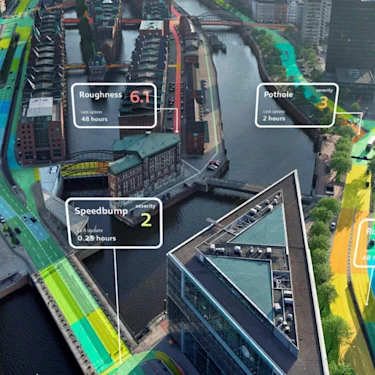AI
Autos
April 5, 2023
Who Is Driving My Car?
Automakers are building increasingly connected, digital and personalized driving experiences. AI is key to all of that.
Words by Patrick George
Photos courtesy CARIAD & Cruise/GM
The year 2023 may end up being remembered as the year the world truly took notice of modern AI, and ChatGPT — the AI-driven chatbot that generates human-like text responses to just about anything you ask it — could prove to be the tip of the spear for this revolution. While the technology is still rapidly evolving and highly controversial, actual applications of its latest version (GPT-4) include coding entire games and auto-generating whole legal documents. Its potential, AI advocates say, could be limitless.
Imagine, then, what it could do inside a vehicle. Last month, General Motors made headlines after it was reported the auto giant was exploring ways to use ChatGPT in vehicles as part of its Microsoft partnership. In a car, GM officials said, ChatGPT could power a voice-activated virtual personal assistant that might explain how to use complicated in-car features, predict when repairs are needed or even explain how to mount a spare tire if you have a blowout. Given how complicated modern cars are becoming, an AI assistant sounds brilliant.
There’s just one problem; the headlines are premature. A GM spokesperson confirmed to Huge Moves that while ChatGPT has many potential in-car applications, the company has no actual agreement to use ChatGPT for any car features, despite some news outlets running a little too far with the story.
“The reality of where we are is that the industry’s in the middle of this big shift to software-defined vehicles,” GM spokesperson Stuart Fowle said. He said GM’s new Ultifi software platform will enable advanced features like over-the-air software updates and better electric vehicle battery management, and “with it in place we will be able to bring cool things like AI voice assistance to customers much faster.”
Nonetheless, everything described so far is not only theoretically possible, it’s in the works at many automakers and supplier companies. The consensus is clear: AI will be the key to unlocking many features and functions that the auto industry defines as its likely future, from automated driving to a degree of personalization that sounds unfathomable today.

A depiction of predicted hazards an automated car might “see.” Photo: CARIAD
A Personalized Experience
The average car in America is now about 12 years old. Take a 2012 Honda CR-V, for example. You’re used to starting it with a physical key, putting gasoline in the tank, maintaining its various parts on a regular schedule and likely using features like navigation and Bluetooth integration for calling and audio streaming.
The cars the auto industry wants to make in the coming decades will be drastically different: They will be mostly battery-electric and increasingly automated, though likely not fully self-driving for decades. They will feature multiple large touch screens with advanced, almost smartphone-like interfaces; offer over-the-air software updates to fix issues; require fewer mechanical repairs; and be connected to a central network and other cars.
And many features you now pay for upfront, including functions like heated seats, may be relegated to monthly subscriptions. You may even need to “subscribe” to the vehicle itself.
It will be an experience defined as much by software as horsepower or driving dynamics, and it will be more personalized. Tomorrow’s cars could offer your favorite movies and games inside, not to mention your preferred settings, even if you get into another vehicle. (This could also mean more targeted ads, likely to no motorist’s delight.)
This, experts say, is where AI might come in. Anthony Pond, the user experience director at Territory Studio, says his firm is working on several software projects for major auto brands like Cadillac and Audi. While he couldn’t speak to specific plans for his clients, he said AI’s ability to learn things about a user will be a major factor in cars to come.
“The car is one of the very few spaces where you control all the senses but taste,” Pond said. “It’s a curated space. And I think as autonomy becomes maybe a bit more of a reality, there are going to be more ways that it can be personalized. And as ownership models shift, the need to create that experience is going to become a bigger part of the offering.”
Software-driven cars will create massive data sets, Pond said, and AI could help use that to personalize what features users are seeing at a certain time, suggest places for them to go, customize their routines and so on. And that could vary for each user’s profile, he said, so that different family members get different experiences and suggestions in the same car — or so that drivers can upload their profile settings when using an entirely new car for the first time. This has clear applications for ride-sharing in the future.
AI might also help different cars offer different experiences to users when driving dynamics cannot. “If you’re in a Ferrari, a Volvo or a BMW, it should feel different,” Pond said. “Part of the brand differentiation going forward will be how AI behaves and how it responds to you and the environment you’re in.”
And then there’s the concept of virtual assistants in vehicles. Right now, many people are familiar with gadgets like Amazon’s Alexa or Google Assistant. Besides helping you manage your schedule, AI-driven virtual assistants could help a car anticipate your needs at a certain time. While voice controls in cars have gotten significantly better in recent years, using them — asking a car to turn the heater up or down, for example — still places the “cognitive load” on a driver, Pond said. Having AI anticipate your needs based on your past preferences could prevent such things.
“We’re in this weird mode where a lot of autonomous stuff is happening, but it’s not fully autonomous,” Pond said. “There’ll be cars on the road that are half autonomous and nonautonomous and fully autonomous, where AI can start to make the drive safer.”

Imagining the future of automated driving. Photo: CARIAD
Improving Autonomy
That future of autonomy all but hinges on AI, said Jan Zawadzki, the head of artificial intelligence at CARIAD, the Volkswagen Group’s in-house software division.
CARIAD officials say they’re exploring numerous AI applications in service of the company’s goal of 40 million connected cars by 2030. “With the help of AI, the software and hardware platform that we’re working on will become the brain — the neural network — of this continuously learning fleet of vehicles,” Zawadzki wrote in 2021.
That will also be key to achieving VW’s goal of Level 4 autonomy, where a car can drive itself within defined roads with human supervision. (Level 2 autonomy is what you find in most modern cars, and Level 5 autonomy is considered completely human-free self-driving, something likely to be many decades away.)
“That is not possible without AI, simple as that,” Zawadzki told Huge Moves. “Nothing beats a neural network.” That term refers to machine learning modeled loosely on the human brain. “Before that, we had older systems that just detected the edges of surfaces,” he said. “But it’s different with AI. You feed it the data, and then the model basically figures out the patterns for itself.”
Automakers including VW are developing autonomy on several fronts, from experimental robo-taxis in cities to further advancing what’s essentially smart cruise control in passenger vehicles. While you cannot buy a truly “self-driving car” today, getting there at all will require further AI research and improvements.
“With AI, the good thing is it’s very easy to achieve 99% accuracy on a given task for many, many use cases,” Zawadzki said. “But for automated driving, that’s not enough. You need to be very, very, very sure the AI is doing exactly what it’s allowed to do.”
A Word of Caution
When it comes to automotive applications of AI — whether that’s virtual assistants or personalizing the in-car experience — a note of caution came up in most of our conversations with industry officials and experts.
This is happening for two reasons: one, the enormous risks around driving in general, and two, the failure of autonomy to deliver on its many promises over the past few years. Last year, Ford- and VW-backed Argo AI went out of business, despite more than $100 billion having been sunk into the self-driving industry, with few viable revenue models in sight. Meanwhile, Tesla, a pioneer in the automated-driving space whose Autopilot is arguably one of the more risk-taking systems, was hit with lawsuits and regulatory actions following a number of high-profile crashes.
Pond added that his automaker clients, especially the older legacy car companies, are approaching AI and autonomy with a great deal of caution in 2023 and beyond.
They aren’t alone. In March, Apple co-founder Steve Wozniak and Tesla CEO Elon Musk signed an open letter urging a pause and independent regulation around machine learning systems. The concern, they said, is that a rush to commercialize AI could lead to an “out-of-control” arms race with unforeseen consequences.
In other words, writing college essays is one thing, but navigating traffic safely is a completely different matter, as is commercializing these technologies. Call it the difference between a fad and the dependable building blocks of tomorrow’s technology.
“The fancy demo time is over,” Zawadzki said. “Eventually we need to make money with this.”
Patrick George is a contributing writer at The Verge, and former editor-in-chief of Jalopnik. He covers the future of transportation.
